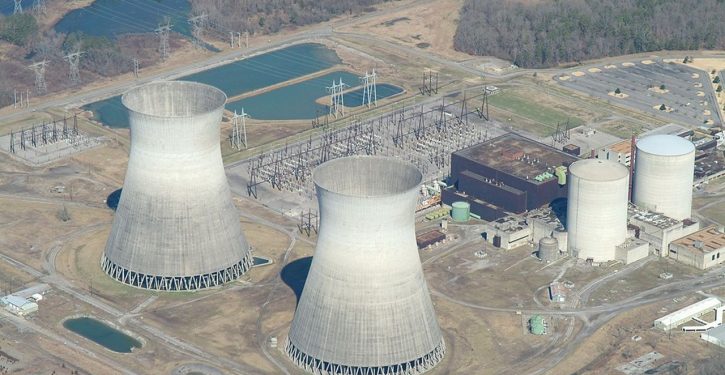
Nuclear power is best for the environment, notes Reason Magazine’s Ronald Bailey, citing a recent study. Yet as he observes, “Germany idiotically shut down its last three nuclear power plants last month. Until 2011, the country obtained one-quarter of its electricity from 17 nuclear power plants. As a December 2022 study in Scientific Reports shows, turning off this carbon-free energy source is incredibly short-sighted for combatting climate change and protecting natural landscapes.”
To get rid of net greenhouse gas emissions by 2050, the world has basically two choices. It can either turn to nuclear power — which would use up only a tiny, 0.016 percent of the Earth’s surface (for uranium mines and nuclear plants) to produce all the needed energy — or turn to biomass for energy, which would consume 96 percent of the world’s land area, causing enormous world hunger and the destruction of ancient forests.
The researchers behind the December 2022 study did a comprehensive assessment of how much land it would take to achieve the Net Zero by 2050 roadmap drafted by the International Energy Agency (IEA) two years ago. That roadmap mandates gradually phasing out the burning of fossil fuels (which emit greenhouse gases) by 2050. The Net Zero plan’s purpose is to keep global average temperatures from rising by less than 1.5 degrees Celsius above the late 19th-century baseline. “This calls for nothing less than a complete transformation of how we produce, transport and consume energy,” the IEA says.
As Bailey observes,
The Scientific Reports study finds that implementing the IEA’s roadmap requires that much of the world’s agricultural and wild lands be sacrificed to produce energy. Biofuels, both liquid and solid, are especially egregious destroyers of the landscape. On the other hand, the energy source that spares the most land is nuclear power. In addition, electricity produced by fission reactors is not intermittent the way that vastly more land-hungry solar and wind power are….[R]esearchers illustrated the vast differences in the amount of energy that can be produced per unit of land by calculating what percentage of land would be needed to meet 100 percent of emissions-free primary energy demand in 2050. Primary energy refers to raw fuels before they have been converted into other forms of energy like electricity, heat, or transport fuels. They calculate that nuclear power generation could supply all the energy demand in 2050 while occupying just 0.016 percent of the world’s land area. On the other hand, using biomass to generate the same amount of energy would take up more than 96 percent of the world’s land area.
Turning to the IEA’s Net Zero roadmap, the team calculates that the … area devoted to growing biomass for energy production (liquid and solid fuels) expands from 653,000 square km (252,000 square miles) to 2,981,000 square km (1,151,000 square miles). It is worth noting that 208,000 square km (80,300 square miles) is now annually plowed up for biofuel production in the U.S. The amount of land covered by onshore wind turbines would rise from 79,000 square km (30,500 square miles) to 995,000 square km (384,000 square miles), and the area covered by solar photovoltaic would increase from 9,400 square km (3,630 square miles) to 270,000 square km (104,000 square miles).
“A sixfold increase will occur in the spatial extent of power generation, from approximately 0.5% of land areas used for electric generation in 2020 to nearly 3.0% of land areas in 2050 (i.e., 430 million hectares of land),” report the researchers. “The world will be electrified by requiring an area roughly equal to the entire European Union (EU), which is one and a half times the size of India. The major contributor to increasing land use will be related to power generation from biomass.”
As the Wall Street Journal reported earlier this week, wind and solar projects occupying massive amounts of land increasingly get NIMBY pushback from disgruntled neighbors…nearly 500 renewable energy projects have been rejected or restricted over the past decade.
The Norwegian University of Science and Technology’s Jonas Kristiansen Nøland notes that “the spatial extent of nuclear power is 99.7% less than onshore wind power—in other words, 350 times less use of land area.” He adds, “An energy transition based on nuclear power alone would save 99.75% of environmental encroachments in 2050. We could even remove most of the current environmental footprint we have already caused.”
As Bailey observes, “Nuclear power massively spares land for nature while producing 24-7 emissions-free electricity. That’s why closing down 17 perfectly good nuclear power plants is environmentally stupid.”
Nuclear plants produce no air pollution or greenhouse gas emissions (they emit only harmless steam into the air). France and Sweden replaced most of their fossil-fueled electricity with nuclear power, and as a result, ended up emitting less than a tenth of the world average of carbon dioxide per kilowatt-hour.
Unlike wind farms, nuclear power plants don’t kill birds. The biggest utility that generates wind power pleaded guilty to federal crimes for killing 150 eagles.
Nuclear power is the safest form of energy we have, if you consider deaths per megawatt of energy produced,” notes Yale University’s Steven Novella. “Wind turbines, surprisingly, kill more people than nuclear plants,” notes Michael Shellenberger, who was named a “Hero of the Environment” by Time magazine. And “solar panels require 17 times more materials in the form of cement, glass, concrete, and steel than do nuclear plants, and create over 200 times more waste,” such as “dust from toxic heavy metals including lead, cadmium, and chromium.”



